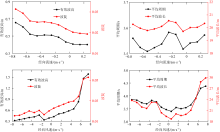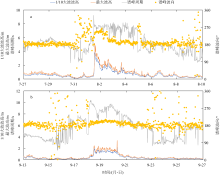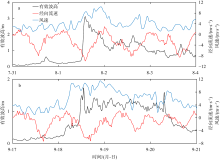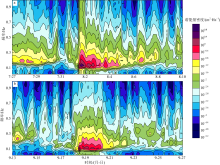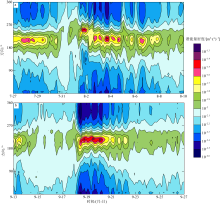| [1] |
范顺庭, 王以谋, 1999. 黄河口海域特征波浪要素比的分析[J]. 海洋预报, 16(1): 22-28.
|
|
FAN SHUNTING, WANG YIMOU, 1999. An analysis for element ratio of characteristic wave over Yellow-River mouth area[J]. Marine Forecasts, 16(1): 22-28 (in Chinese with English abstract).
|
| [2] |
冯兴如, 李近元, 尹宝树, 等, 2018. 海南东方近岸海域海浪观测特征研究[J]. 热带海洋学报, 37(3): 1-8.
doi: 10.11978/2017102
|
|
FENG XINGRU, LI JINYUAN, YIN BAOSHU, et al, 2018. Characteristics of ocean waves in coastal area of Dongfang, Hainan Island based on observations[J]. Journal of Tropical Oceanography, 37(3): 1-8 (in Chinese with English abstract).
doi: 10.11978/2017102
|
| [3] |
葛明达, 1984. 连云港波高波周期统计分布[J]. 海洋工程, (1): 40-50.
|
|
GE MINGDA, 1984. Distributions of wave heights and periods in Lianyun Harbour[J]. Ocean Engineering, (1): 40-50 (in Chinese with English abstract).
|
| [4] |
黄心裕, 唐军, 王晓宇, 2022. 基于Prophet算法的海南近海波浪长时段时序分析与预测[J]. 海洋学报, 44(4): 114-121.
|
|
HUANG XINYU, TANG JUN, WANG XIAOYU, 2022. Long term time series analysis and prediction of waves at Hainan offshore zone based on Prophet algorithm[J]. Acta Oceanologica Sinica, 44(4): 114-121 (in Chinese with English abstract).
|
| [5] |
李淑江, 李泽文, 范斌, 等, 2016. 海南岛东南近岸海浪观测及统计特征[J]. 海洋科学进展, 34(1): 1-9.
|
|
LI SHUJIANG, LI ZEWEN, FAN BIN, et al, 2016. Wave observation and statistical analysis in the southeast coast of Hainan Island[J]. Advances in Marine Science, 34(1): 1-9 (in Chinese with English abstract).
|
| [6] |
孙璐, 黄楚光, 蔡伟叙, 等, 2014. 广海湾海浪要素的基本特征及典型台风过程的波浪分析[J]. 热带海洋学报, 33(3): 17-23.
|
|
SUN LU, HUANG CHUGUANG, CAI WEIXU, et al, 2014. Statistical analysis of wave characteristics in the Guanghai Bay[J]. Journal of Tropical Oceanography, 33(3): 17-23 (in Chinese with English abstract).
doi: 10.11978/j.issn.1009-5470.2014.03.003
|
| [7] |
严珍珍, 杜小平, 范湘涛, 2019. 三亚湾海岸动力演变的数值模拟研究[J]. 海岸工程, 38(3): 176-186.
|
|
YAN ZHENZHEN, DU XIAOPING, FAN XIANGTAO, 2019. Numerical simulation of coastal dynamic evolution of the Sanya Bay[J]. Coastal Engineering, 38(3): 176-186 (in Chinese with English abstract).
|
| [8] |
姚顺, 马宁, 丁俊杰, 等, 2021. 规则波与流相互作用的数值模拟与不确定度分析[J]. 哈尔滨工程大学学报, 42(2): 172-178.
|
|
YAO SHUN, MA NING, DING JUNJIE, et al, 2021. Numerical simulation and uncertainty analysis of wave-current interaction with regular waves[J]. Journal of Harbin Engineering University, 42(2): 172-178 (in Chinese with English abstract).
|
| [9] |
张存智, 张健民, 窦振兴, 等, 1995. 三亚电厂码头航道泥沙洄淤预测[J]. 海洋环境科学, 14(4): 1-8.
|
|
ZHANG CUNZHI, ZHANG JIANMIN, DOU ZHENXING, et al, 1995. Prediction of siltation in the approach channel to Sanya power station[J]. Marine Environmental Science, 14(4): 1-8 (in Chinese with English abstract).
|
| [10] |
HU HENGYU, HE ZHENGWEI, LING YANFANG, et al, 2022. A SOM-RBFnn-based calibration algorithm of modeled significant wave height for nearshore areas[J]. Journal of Marine Science and Engineering, 10(5): 706.
doi: 10.3390/jmse10050706
|
| [11] |
LAWSON N V, ABERNETHY C L, 1975. Long term wave statistics off Botany Bay[C]. Proceedings of the Second Australian Conference on Coastal and Ocean Engineering. Sydney, Australia. Institution of Engineers: 169-178.
|
| [12] |
LI AILIAN, GUAN SHOUDE, MO DONGXUE, et al, 2020a. Modeling wave effects on storm surge from different typhoon intensities and sizes in the South China Sea[J]. Estuarine, Coastal and Shelf Science, 235: 106551.
doi: 10.1016/j.ecss.2019.106551
|
| [13] |
LI BO, CHEN WUYANG, LI JUNMIN, et al, 2022a. Integrated monitoring and assessments of marine energy for a small uninhabited island[J]. Energy Reports, 8(4): 63-72.
|
| [14] |
LI BO, CHEN WUYANG, LI JUNMIN, et al, 2022b. Wave energy assessment based on reanalysis data calibrated by buoy observations in the southern South China Sea[J]. Energy Reports, 8: 5067-5079.
doi: 10.1016/j.egyr.2022.03.177
|
| [15] |
LI BO, CHEN WUYANG, LIU JUNLIANG, et al, 2020b. Construction and application of nearshore hydrodynamic monitoring system for uninhabited islands[J]. Journal of Coastal Research, 99(S1): 131-136.
doi: 10.2112/SI99-019.1
|
| [16] |
LIU JUNLIANG, CHEN WUYANG, LI JUNMIN, et al, 2022. Observed wave energy variations in coastal regions of the northern South China Sea during Typhoon Lupit (2021)[J]. Energy Reports, 8(7): 240-248.
|
| [17] |
LIU JUNLIANG, HE YINGHUI, LI JUAN, et al, 2018. Cases study of nonlinear interaction between near-inertial waves induced by typhoon and diurnal tides near the Xisha Islands[J]. Journal of Geophysical Research: Oceans, 123(4): 2768-2784.
doi: 10.1029/2017JC013555
|
| [18] |
QI WEN-GANG, LI CHANG-FEI, JENG DONGSHENG, et al, 2019. Combined wave-current induced excess pore-pressure in a sandy seabed: Flume observations and comparisons with theoretical models[J]. Coastal Engineering, 147: 89-98.
doi: 10.1016/j.coastaleng.2019.02.006
|
| [19] |
SU HUI, WEI CHUNLEI, JIANG SHAOCAI, et al, 2017. Revisiting the seasonal wave height variability in the South China Sea with merged satellite altimetry observations[J]. Acta Oceanologica Sinica, 36(11): 38-50.
doi: 10.1007/s13131-017-1073-4
|
 ), 李博1,3, 陈武阳1, 刘军亮1,3(
), 李博1,3, 陈武阳1, 刘军亮1,3( )
)
 ), LI Bo1,3, CHEN Wuyang1, LIU Junliang1,3(
), LI Bo1,3, CHEN Wuyang1, LIU Junliang1,3( )
)




















